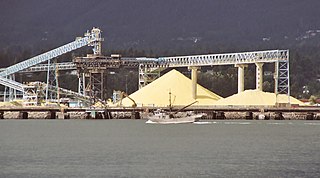
A conveyor belt is the carrying medium of a belt conveyor system. A belt conveyor system is one of many types of conveyor systems. A belt conveyor system consists of two or more pulleys, with a closed loop of carrying medium—the conveyor belt—that rotates about them. One or both of the pulleys are powered, moving the belt and the material on the belt forward. The powered pulley is called the drive pulley while the unpowered pulley is called the idler pulley. There are two main industrial classes of belt conveyors; Those in general material handling such as those moving boxes along inside a factory and bulk material handling such as those used to transport large volumes of resources and agricultural materials, such as grain, salt, coal, ore, sand, overburden and more.

A water slide is a type of slide designed for warm-weather or indoor recreational use at water parks. Water slides differ in their riding method and therefore size. Some slides require riders to sit directly on the slide, or on a raft or tube designed to be used with the slide.

Conveyor belt sushi, also called "rotation sushi" is a form of sushi restaurant common in Japan. In Australasia, it is also known as a sushi train.
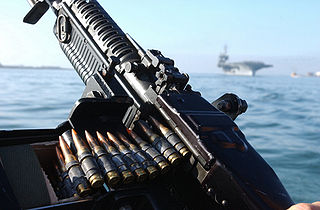
An ammunition belt is a firearm device used to package and feed cartridges, typically for rapid-firing automatic weapons such as machine guns. Belt-fed systems minimize the proportional weight of the ammunition apparatus to the entire weapon system, and allow high rates of continuous fire without needing frequent magazine changes. The capacity of belts and associated belt containers is typically a function of weight and bulk, and their size is limited by caliber and the combined portability of the weapon and ammunition. The most common ammo capacity typically carried on a man-portable weapon system vary from 50 to 300 rounds.

A bucket-wheel excavator (BWE) is a large heavy equipment machine used in surface mining.

A baggage carousel is a device, generally at an airport, that delivers checked luggage to the passengers at the baggage reclaim area at their final destination. Not all airports use these devices. Airports without carousels generally deliver baggage by placing it on the floor or sliding it through an opening in a wall.
The Chicago Area Consolidation Hub (CACH) is a package sorting facility for United Parcel Service, located in the village of Hodgkins, Illinois.

In bowling, a pinsetter or pinspotter is an automated mechanical device that sets bowling pins back in their original positions, returns bowling balls to the front of the alley, and clears fallen pins on the pin deck. Prior to the machine's invention, pinsetters were originally boys or young men stationed at bowling alleys to manually reset pins and return the ball. The first mechanical pinsetter was invented by Gottfried (Fred) Schmidt, who sold the patent in 1941 to AMF. Pinsetting machines have largely done away with pinsetting as a manual profession, although a small number of bowling alleys still use human pinsetters. While humans usually no longer set the pins, a pinchaser, or in slang "pin monkey", is often stationed near the equipment to ensure it is clean and working properly, and to clear minor jams.
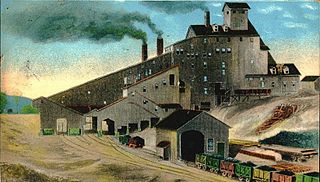
A coal breaker is a coal processing plant which breaks coal into various useful sizes. Coal breakers also remove impurities from the coal and deposit them into a culm dump. The coal breaker is a forerunner of the modern coal preparation plant.
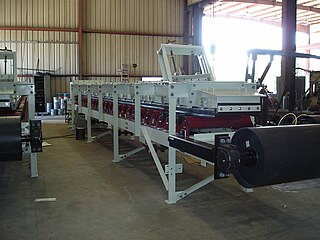
A variable rate feeder is a piece of industrial control equipment used to deliver solid material at a known rate into some process.
Material handling equipment (MHE) is mechanical equipment used for the movement, storage, control and protection of materials, goods and products throughout the process of manufacturing, distribution, consumption and disposal. The different types of handling equipment can be classified into four major categories: transport equipment, positioning equipment, unit load formation equipment, and storage equipment.

A conveyor system is a common piece of mechanical handling equipment that moves materials from one location to another. Conveyors are especially useful in applications involving the transport of heavy or bulky materials. Conveyor systems allow quick and efficient transport for a wide variety of materials, which make them very popular in the material handling and packaging industries. They also have popular consumer applications, as they are often found in supermarkets and airports, constituting the final leg of item/ bag delivery to customers. Many kinds of conveying systems are available and are used according to the various needs of different industries. There are chain conveyors as well. Chain conveyors consist of enclosed tracks, I-Beam, towline, power & free, and hand pushed trolleys.

Heathrow Worldwide Distribution Centre (HWDC) is a sorting office for inbound and outbound international mail operated by Royal Mail. Located close to Heathrow Airport, the HWDC is situated in the town of Langley, Berkshire, near Slough, and began operations in 2003. The centre is often referred to by its abbreviation, Langley HWDC, or as 'GBLALA' in mail tracking information.

Le Scoot is a log flume ride at Busch Gardens Williamsburg located in the New France area. It is themed after mountains and a saw mill.
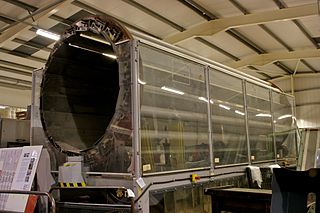
Mail sorting refers to the methods by which postal systems determine how and where to route mail for delivery. Once accomplished by hand, mail sorting is now largely automated through the aid of specialized machines. The first widely adopted mail sorting machine was the Transorma, first made operational in Rotterdam in 1930.

A goods station or freight station is, in the widest sense, a railway station where, either exclusively or predominantly, goods, such as merchandise, parcels, and manufactured items, are loaded onto or unloaded off of ships or road vehicles and/or where goods wagons are transferred to local sidings.
Optical sorting is the automated process of sorting solid products using cameras and/or lasers.

Colour sorters or color sorters are machines that are used on the production lines in bulk food processing and other industries. They separate items by their colours, detecting the colours of things that pass before them, and using mechanical or pneumatic ejection devices to divert items whose colours do not fall within the acceptable range or which are desired to form a separate group from the rest.
Japanizi "Going, Going, Gong!" ("ゴーイング、ゴーイング、ゴング!") is a Canadian children's physical game show with a Japanese motif where contestants compete with a teammate against other teams as they tackle obstacles and challenges to test their mental capabilities, strength, endurance, and smarts. The series first aired on YTV starting 5 November 2013 and in the United States on Disney XD as of 4 November 2013.

In logistics, a sorter is a system which performs sortation of products according to their destinations.
















